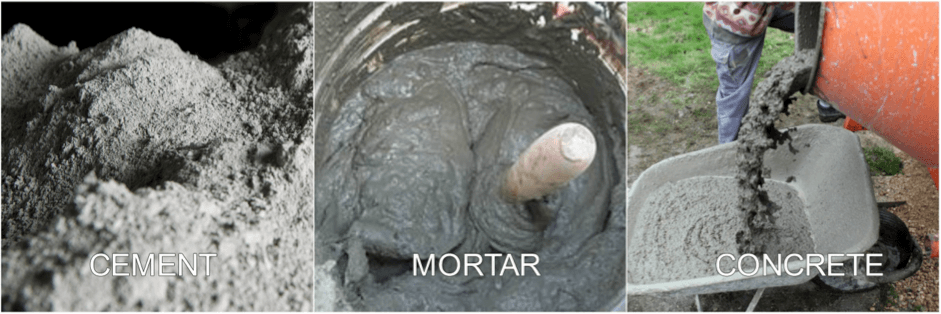Difference between Concrete Cement and Mortar
Cement, concrete and mortar have differences in their composition, such as how much water, sand and / or gravel they use. As well as this, they all have vastly different uses. It’s also not uncommon for people to confuse the single material of CEMENT with the four part material of CONCRETE. However, after this article you will have a great understanding of the differences and be able to identify what one is what and what one suits your project best.

CEMENT – cement is a fine binding powder (which is never used alone)
Cement is a binder; its purpose is to hold a combination of materials together to form concrete or mortar products. Remember however, you can’t just use cement alone – you need other materials and what you mix with the cement will determine the final product!
Cement is made from limestone, calcium, silicon, iron, and aluminum, among other ingredients. This mixture is heated in large kilns to about 2,700°F (1,482°C) to form a product known as clinker, which roughly resemble marbles. These are ground into a powder and gypsum (a soft sulphate mineral and main ingredient of blackboard chalk) is added, creating a gray flour-like substance known as cement. There are many different types of cement, but the type most commonly used in construction is Ordinary Portland Cement (OPC).
OPC is a type of “hydraulic” cement, which simply means that if water is added to it, a chemical reaction will be triggered that will allow it solidify and set rock hard.
MORTAR – mortar is composed of cement, sand and water
Mortar is used to hold building materials such as brick, blocks and / or stone together and is a mix of:
Water is used to trigger the chemical hardening process by hydrating the cement. The cement coats the sand and ‘cuddles’ it into a solid high strengh THICK bonding element, capable of sticking bricks, blocks and or stones together for long durations.
CONCRETE – concrete is composed of cement, sand, gravel and water
Concrete is versatile and can be used in many applications e.g. you’ll find concrete in foundations, patios, shed and conservatory bases, car parks, farm yard hard-standings, retaining wall structures, swimming pools, high rise buildings even birdbaths and sailboats.
Concrete is a composite of:
Note: sand and gravel together are known especially in the concrete industry as “AGGREGATE”.
Generally cement makes up 10 -15% of the total mass of concrete; although the exact proportions vary depending on the type and or strenght type of concrete being made.
Aggregate makes up more than 60% of a concrete mix and can sometimes even reach up to 80%. The aggregate gives the concrete its mass and the sand in aggregate also helps to expel air by filling gaps between the larger particles of gravel all making the mass compact and solid.
Like a mortar mix, when water is added to a concrete mix, the cement becomes hydrated activating its binding characteristics which holds the mix together and begins the hardening process.
The proportions of a concrete mix will determine its workability, its strength, its resistance to freeze and thaw and how long it takes to harden.
Unlike a mortar mix, concrete has a lower water to cement ratio, which can be regarded as a THIN mix and as such it is not suitable as a bonding agent , it is however used for MANY MANY other applications some of which are described above.
For more information please view our page on Cement Grades and Types of Ready Mix Concrete.

